Episode #375: 19 Years of Teaching Through Math Tasks Advice in 25 Minutes
LISTEN NOW HERE…
WATCH NOW…
In this reflective and candid episode, we dive into the lessons we’ve learned since shifting to a task-based approach to teaching math. With over 19 years (combined) of experience experimenting, adjusting, and growing, we each share one key insight we wish we had known earlier. From choosing the right math task to setting up your classroom for engagement and productive struggle, we unpack the subtle (and not-so-subtle) shifts that have made a lasting impact on our math instruction. We’ll also touch on the role of direct instruction—how our stance has evolved and what we now believe about its place within task-based learning. Whether you’re just getting started with teaching math through tasks or have been on this journey for a while, this episode is packed with real talk, reflection, and actionable insights to strengthen your math practice.
In this episode, you’ll discover:
- The importance of purposefully selecting math tasks that spark thinking and align with learning goals.
- How classroom setup and student positioning can either amplify or hinder meaningful engagement in math class.
- Why vulnerability and reflection are essential for growing as a math educator.
- Lessons learned about balancing exploration and explicit instruction in math lessons.
- What we would do differently if we could go back—and what we’ll continue to refine moving forward.
Attention District Math Leaders:
Visit Keenan and Jake’s website: skillsbasedclassroom.com
Not sure what matters most when designing math improvement plans? Take this assessment and get a free customized report: https://makemathmoments.com/grow/
Ready to design your math improvement plan with guidance, support and using structure? Learn how to follow our 4 stage process. https://growyourmathprogram.com
Looking to supplement your curriculum with problem based lessons and units? Make Math Moments Problem Based Lessons & Units
Be Our Next Podcast Guest!
Join as an Interview Guest or on a Mentoring Moment Call
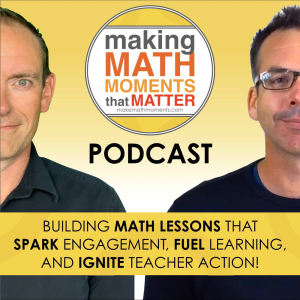
Apply to be a Featured Interview Guest
Book a Mentoring Moment Coaching Call
Are You an Official Math Moment Maker?
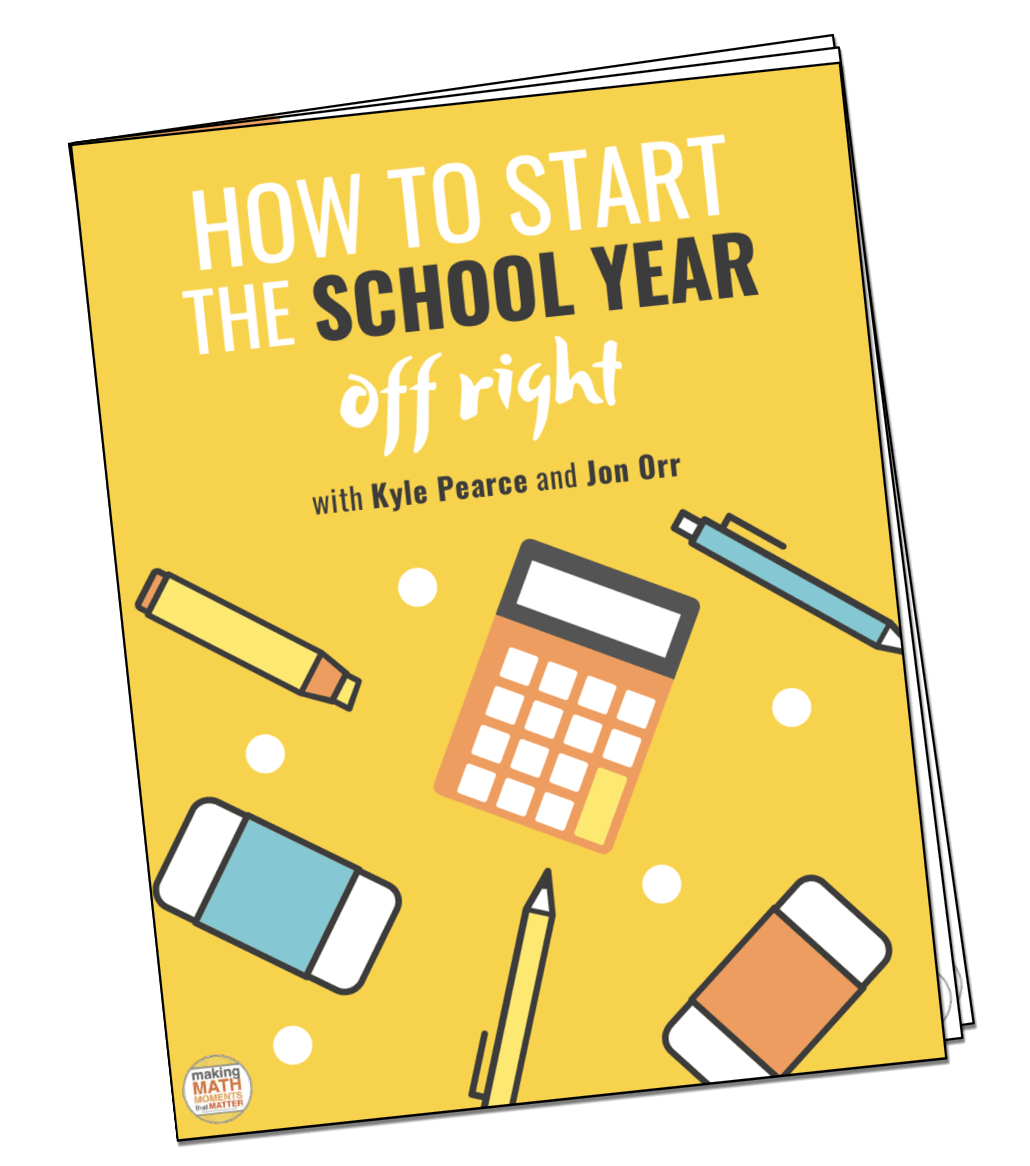
FULL TRANSCRIPT
Yvette Lehman: Today we’re gonna talk to our past selves, John. We’re gonna, yeah, we’re gonna go back in time and we’re gonna tell ourselves what we wish we’d known 10 years ago when it comes to a task-based approach to math instruction. We’ve been on this journey, right?
Jon Orr: Let’s do it, let’s do it. Yeah, I wish I could just top in the DeLorean. You know, we’re gonna go back 30, no, 20, no, ooh, almost 20 years for me. A little bit less than 20 years to talk about what I would do differently. I like it, I like it, let’s go. Set the stage, like what do we wanna tell ourselves about? You what is the topic that we’re gonna kind of guide ourselves on?
Yvette Lehman: First, we’re gonna tell ourselves that we value a task-based approach and it’s a critical component of an effective math program, which I think we knew then, but I wanna almost confirm that we still believe that now. Like having been on this journey, it’s like, this is worthwhile.
Jon Orr: Yeah, if I go back, sure. Like that would be the first thing I would need to convince myself, because I taught very traditionally as a high school math teacher for, like yeah, I was doing some different things, but I was still very much, you know, direct instruction, but I would try to weave in like technological aspects, but it was still very much like a here’s what we do, here’s your homework, let’s take it up, here’s what we do, here’s your homework, let’s take it up, you know, approach.
And then I had like sprinkles of say, different things happening during the year. But then those last 10 years were what you were talking about here. And what we’ve talked about in you know, this is episode 375 of the Making Math Moments That Matter podcast. And in almost all of especially those early ones were about how to teach problem based lessons and how to teach through tasks. So, you know, going back, first thing I would have to convince myself is to say like,
you need to switch earlier because like you probably need to go apologize to some kids for perpetuating like the stereotypical like this is math class and it could be something different that gets more kids thinking, it gets more kids to like math, it gets more kids to see the relevancy of math. So that would be the first thing but I know that I got more to talk about to pass John while John is actually teaching problem-based lessons and what to do differently.
Yvette Lehman: Same. I think what happened for me is I knew that what I was doing wasn’t working, right? So, you know, flipping the page in the textbook, funneling students to a particular procedure that nobody understood. And I knew that I wasn’t getting retention for students. It’s like we would write the quiz and then they’d forget everything. And it’s as if I never taught it. So going to a task based approach that was student centered, where students were working collaboratively, I think the biggest shift that I saw is that
students started to believe that they were capable and they saw themselves as mathematicians and they saw that they were capable of reasoning and problem solving. But I think I went too far on the now a task-based approach is going to be my entire program and I’m going to run one of these lessons five days a week. And kids are going to, I’m going to honor where kids enter. So if kids enter at one-to-one counting,
If kids enter at skip counting, if kids enter at repeated addition, I’m going to honor where they are. And I would consolidate and I would connect different representations. And then the next day I’d move on to the next task. And I think, right, like it’s just like task after task after task after task.
Jon Orr: You just repeat. got it. So you were like, I’m gonna, I think you said this, but I mean, you’re saying like every day I’m gonna teach through a problem. Kids are gonna be attempting new things, new scenario every day. And then what did the connect look like? Like, cause that part makes me go like, was that enough then, you know?
Yvette Lehman: No way! So I would weave the most beautiful consolidation you’ve ever seen, John. For me. could connect the one-to-one counting to the, you know, skip counting on the number line to the partial products in the open array. I’m making connections.
Jon Orr: So you’re seeing like, setting a stage, it’s like, you’re seeing stuff, kids are, you know, whether you’re at the tables or whether you’re on the, standing up, like you’re seeing kids with their different solutions to the problem that you’ve, you you’ve presented. And you’re like, highlighting the student, student, like evidence of student learning, you’re highlighting, you’re highlighting that around the room and going like, here’s how this might connect to this version. And this, you know, so and so’s version is connected, like, is that what you’re imagining? Is that what you’re doing? Okay.
Yvette Lehman: Yeah, I’m sure. 100%. So I’m like, I can see John’s thinking in, know, John used one-to-one counting, but can we see John’s thinking in Yvette’s thinking? like, like I am, you know, making connections amongst representations. I’m eliciting evidence of student thinking.
Jon Orr: Interesting. And what did you do after that?
Yvette Lehman: I would do a consolidation journal. So essentially, everyday students would do a reflection where they would reflect on the learning goal or the success criteria and then they would apply it. So I’d give them another task.
Jon Orr: Mmm. And then tomorrow was another day. Is okay?
Yvette Lehman: Yeah, it’s a lot of tasks, five days of tasks.
Jon Orr: five days of tasks, when was the practicing of the, like let’s say you emerged this strategy through this task that you wanted students to like grapple in, you connected it and you’re like, yes, this is what we’re focusing on here and here’s my reflection journal. When is that like, now let’s apply it or practice it and apply it again and practice, that later or is that like at the end of the week?
Yvette Lehman: So I’m going to tell you how my, I’m going to tell you how my tasks. that was tenure, you know, 10 years ago, this was me. I went all in on tasks. The next evolution was I, I’ve talked about this on the podcast before, is I went to my two day structure where it’s like day one is a task and then day two is purposeful practice in small groups.
Jon Orr: Yeah, yeah, no, I get it. I get it. Yep. Yep. Okay.
Yvette Lehman: So based on the consolidation journal, I would then pull my targeted small groups to provide tier two instruction. I would give students opportunities to practice the big ideas that had emerged through my consolidation. That was better.
I’m getting closer, but here’s where I am now. And I’m going to come at this from an elementary perspective, where students are earlier in their journey. I often say, please come at me, math community, if you don’t agree with this statement, I’m OK with that.
Math requires a level of abstraction that to me becomes most accessible around fourth grade. So like first through third, we’re fairly concrete and we’re certainly rooting ourselves in foundational skills around counting principles, for example, and stable order and all of these things. But, you know, math becomes increasingly abstract and it’s really around fourth grade. In fourth grade, it’s almost as if I feel like we’re starting again because the world has become
increasingly abstract and we have to continuously make these connections between concrete and abstract. Okay, let’s keep that in mind. So I feel like when we get to these junior grades, there’s so much learning for students to do and we can’t make assumptions all the time about the prior knowledge that they bring because maybe their prior knowledge was rooted in this really concrete world and now we’re asking them for abstraction. So with that being said, I think that what I didn’t do well even in my
modified version of this task-based approach is that the kids who were one-to-one counting or skip counting were still one-to-one counting and skip counting months later because the dosage that they need to actually develop strategic competence around the strategies that I wanted them actually using in those tasks, I wasn’t giving them a high enough dosage.
and I wasn’t being explicit enough. And I remember reading, figuring out fluency, and there’s a quote in there, I’ve said it before, and I am gonna say it again. Like, students can’t choose the strategy in problem solving if they don’t learn to use it. So it’s like they need, you know, to be explicitly introduced to a strategy through context, through models, through relevant scenarios, but then they need to play games with it. They need a high dosage of practice.
I know that right now Pam Harris is doing a lot of work around problem strings and she talks about like that high dosage of patterns for students to really internalize these relationships between quantities and operators. And so I think that although I think I tried to provide open tasks that were low floor, high ceiling, and I honoured student thinking and I leveraged in thinking and I introduced models and a variety of strategies, I wasn’t giving them nearly high enough of a dosage.
for them to own those strategies and models and confidently use them. Because I was moving on to the next task constantly.
Jon Orr: Right. So that I’m then now this just brings up more, you know, questions because it’s like, what was the—because you were moving on, was it—was it the pressure of the—you know, got to get through the curriculum or got to get through, you know, the standards here and it’s like I’m going to move on without—like I know that you’ve talked openly and strongly about—
exit tickets and going like, I’ve collected that but then what did you like, was it like, I’m not, I’m not actually using that to tell me that tomorrow, like, we didn’t transfer, you know, we don’t have evidence that says that they can use it after we’ve consolidated. Was it like, maybe that wasn’t part of your repertoire at that time.
Yvette Lehman: I think that I honoured at the time where students were on their own developmental trajectory. And so it’s like I almost, you know, valued where they were entering because they were accessing, even if it wasn’t, I wasn’t focused on efficiency and flexibility enough. Like I would honour that they could access the task. It’s like you, you solve this task. You solved it through skip counting. It’s not efficient.
It’s not flexible, you use that same strategy every time, but I’m like, but you solve the task. Where it’s like, now I recognize that, you if we want students to be efficient and flexible and truly strategic, you know, build strategic competence, I can’t expect that it’s going to emerge developmentally organically for all students just through experience. I have to explicitly teach it and give high, a high dosage of opportunities to practice it and apply it.
Jon Orr: Right. Yeah. And also to like, I think, partly what I’ve, I’ve, I’ve not heard is like this understanding of like, what does the success criteria look like for when students consistently can demonstrate this key outcome or this key learning or this learning goal, which was around maybe that strategy or that idea. Like it was like, we’re here’s the idea or I’ve consolidated the idea.
I’m moving on, but I’m not actually looking to see where students, individual students are on the consistency of using that on an ongoing basis. Is that fair?
Yvette Lehman: I think so. And I think it’s just my own understanding of fluency at the time. Like I wasn’t, I, again, like I think I was just looking for access and like, could they solve the task?
Jon Orr: Right. So, but the task, like that’s, that’s the part it’s like, okay, so, but the task isn’t the standard, right? So the task is the context, at least the standard. So it’s like, I’m, I’m putting, I’m putting all the emphasis on this task I’ve chosen that supposed to be in the, this standard world. but I’m not actually assessing where students are on their, you know, what they can understand and do, around that standard.
Yvette Lehman: And I would say that here in Ontario in our revised math curriculum, the curriculum is very explicit about the strategies that they want them using. So it’s like, okay, we’re going to solve division problems where it used to just say division and it would like division can be interpreted a lot of different ways. And it would just say like using a variety of strategies. Well, you know, repeated subtraction is a strategy. So I would have honoured repeated subtraction as one of the strategies that students need, you know, that students can use to divide.
where now it’s getting a lot more explicit and it really identifies like which strategies students should be using at that grade level. And I think that would have helped me, right? Like when it was very vague before, it was very open as far as like, here’s a laundry list of different strategies you can use to divide. Now it’s more clear, I think in the 2020 revisions around, this is, we’re working on the flexible algorithm.
So students aren’t using the flexible algorithm, then they haven’t met the depth of this standard or expectation. So that’s why I tell myself, I’d be like, yes, it’s great to have low floor, high ceiling tasks. Yes, it’s great to honor how students approach them. But how do I ensure that, you know, the strategy, like you mentioned, like the strategy and the model that we’re actually trying to get to, that’s going to be efficient, it’s going to serve them long-term. If students don’t own that strategy, I was already on to the next task.
Jon Orr: All right, and I think I’m glad you summarized and shared and you were very open to sharing here. So thank you for being brave. And I think mine is somewhat related. Like we were like, were like, what are you gonna share? And you’re like, I don’t wanna share the same as you. But in a way it’s somewhat similar, like the line of questioning that I was kind of discussing, asking you about is really where my wish,
would was lying, which was about the intentionality of the lesson. You know, and I think I think when we first got into teaching through problem based lessons, and it sounded like what I was doing was it sounding like what you were doing was like, I’m going to teach the task because the task is engaging. And the task became the the thing which was not actually the thing that we needed to make the point of the lesson.
And a lot of times I used to also go like, well, I’m going to teach the task on Friday because it’s a problem solving Friday. And it’s just something that I put in for fun or for engagement. wasn’t, I didn’t use it to be very specific in towards what I want students to gain out of this. like my intentionality wasn’t where it needed to be. So if you think about like, why select this task? What is the big ideas that we want to emerge in this task? What is the learning goal?
that I want students to take away from this task? What are the specific skills that I want them to say now practice or, you know, problem solve with say that big idea as the next component? Because I think unlike you, like I be living in high school land, I always wanted to still use my time slot to almost replicate what I used to do, which was like, here’s the idea. Here’s how you do it. Go practice like
it’s that was like, those are like the three parts other than taking up homework, the four pieces of math class that were ingrained in all of us high school teachers to replicate. So when I started to teach through problem based lessons, I’m like, well, maybe I can switch out the the the introduced part differently. But then I still needed to get the practice in there. So it was like, I was always trying to think about how do I get that practice in there. But then it was like, I’m, maybe I’ll just use this task to practice with.
as part of it. And that’s another part that I would change because where I ended up was the task became, the way to introduce, say, different strategies around the room from where kids currently were could have been based off last year’s learning or this year’s learning. Like you’re saying, we were honoring what they’re bringing to solve with this task. But then because I morphed into having a very, very specific learning goal that I wanted to emerge,
in that and so then became crafting the the experience to either try my try our best to craft to get that out. And I always knew as a high school teacher that if it didn’t come out, which was likely because like you’re saying I didn’t front like I wasn’t trying to make sure kids had the strategies in advance to solve problems. I was trying to create more of an experience to emerge why this strategy might be better than another strategy.
And so that became the focus of the end of the lesson. And we started to tie that up with a bow and make it very clear that this was the learning goal today. So that’s like where our learning goals came out was near the end of the lesson. you know, I used to just kind of let that go and not have the tying with the bow. And in a lot of times I’m sure kids were walking out going like, that was kind of fun, but I don’t know what we were doing in math. Like, I don’t know what my learning goal here today was. So when we started to be more specific at the end of the lesson or it was happening in the middle of the lesson.
what the learning goal was, what is the next set of expectations? Here’s what we’re going to do now to practice that learning goal or that strategy. Maybe we emerge the double number line as a model to solve proportions through this context task, but now the last third of this class is now practicing how to use that specific model or that specific strategy in part B or the next context or another problem.
that’s similar so that I can now gain the assessment knowledge that I need to see is here’s the model, the learning goal that we’re trying to establish today. Can I, that’s like my exit ticket. Can we now see that we have now grappled with that enough in class and now as a homework, let’s go now practice that in homework and we’ll repeat that next day. So that was the way I structured it. in summary, I wish I could go back and say, be more intentional about.
why you’re at this task and what is the purpose of engaging students in this task and make sure that it’s clear to everyone involved by the end or before the end so that you can then help kids understand where it applies next.
Yvette Lehman: I started this conversation by saying, I don’t want anything that we say to deter people from a problem-based, task-based approach, because to us, it’s like, that’s what math is about. It’s about positioning students as thinkers and problem solvers, and to give them the confidence that they have the ability to work their way through a cognitively demanding task, and that through collaboration and problem solving, they are capable.
I think that what we’re saying though is taking that approach without teacher clarity around the explicit learning goal that you’re trying to emerge can be problematic. And I think for me, the problem was I was okay leaving kids where they were developmentally as long as they had access. So I was kind of going almost really far to the extreme of honouring student thinking without thinking about the
a number of opportunities they would need to internalize this. Like I would present the strategy, but I didn’t give them a chance to internalize that strategy and be positioned to leverage it as a tool for thinking before I was already moving on.
So I think that, know, again, like I, maybe now what I would do if I’m back in the classroom next year, it’s like I would kick off the unit with a task to get an understanding of where students are entering. I would engage them in learning that was explicit, but also through games, through centers, through repeated opportunities to explore relationships between.
operators, models, and number, you know, like really for them to build their reasoning and then also then give them another opportunity to apply that reasoning through another open-ended task. Like it’s like, I’d almost like sandwich.
in some way. and I haven’t done this yet. So, you know, don’t take my word for it, but that’s what I’m envisioning now. It’s like I start with the high, you low floor, high ceiling, high cognitive demand task. I gather assessment information about entry point. I create experiences to move them toward efficiency, flexibility, and accuracy through the use of a variety of strategies and models that I’ve targeted. And then I give them another chance to now apply them through problem solving.
Jon Orr: Right, What you’re saying is you’re trying to design, you know, you’re trying to, and this is the summary in a way, is to say like, all of these things, what they do is give you more opportunity to see where students are on the success criteria for that learning goal. So when you’re thinking about, like you have to have that clear picture in your mind, so how you can structure the introductory contextual tasks.
why you’re going to pick this game or this game or this game, because you’re trying to gain information when you’re observing or where kids are practicing, but you’re trying to take in the information on where kids are on their use of say that model or that strategy or that understanding of that learning goal. Like all of these things are about trying to give you information that says that they are progressing. And that’s why teaching through problem-based tasks is a great way to kind of gain that initially, but then do what is required.
to get them to that spot and get you the information you need to pivot or proceed, you know, with the, the next component or the next center or the next small group or the next, you know, activity because that’s what teaching is, right, is to gain this. And that’s why problem-based lessons are a great way because they, the direct instruction way that I was teaching is like, didn’t gain any information from kids. would share the information. And the only time that I gained it was when I would go walk, you know, one on one and with kids or kids would come back to my desk because I went and sat down. That’s, that’s, that’s, go ahead. Right. Sure.
Yvette Lehman: Right. And who was doing the thinking, right? Like that’s at the root of why we want to adopt this approach. It’s like students need to be doing the thinking. I mentioned this, we recently hosted a PD. Like I don’t want to be funneling anybody to not think and simply follow steps. Like my entire goal of developing a math program is to promote reasoning and problem solving.
And so I have to create the opportunities for them to do that. But I also have to build their capacity to reason and problem solving with that high dosage that we’re describing, where it’s like, if I’m going to explicitly, if I want to see them using partial products for a quotative division problem, using an open array, they’re not just going to naturally stumble upon that through a task. I have to explicitly teach it.
and give them an opportunity to live in it, breathe in it, apply it, see its relevance so that it becomes a tool in their toolkit. It’s not just gonna, you know, organically emerge because the task was interesting and cognitively demanding.
Jon Orr: Well, we talked a lot about what we would go back and share with our past selves. Hopefully you had some takeaways here today. When we think about the six components of effective mathematics classrooms or mathematics programs at the school level or the district level, we definitely touched on a few of those pieces of the tree here today, specifically the branches of the tree, which is our pedagogical moves, the choices we make in our math class.
which we know are heavily relied upon or strengthened when we strengthen the roots of our tree, which is our own current mathematical understandings, you know, our own conceptual understanding and how it relates to the learning of students. Those two things are probably heavily weighted here today when we talk about how to choose math tasks, why you’re gonna make the moves, what we can do differently when reflecting upon the moves, the branches that we’ve used.
to strengthen our tree. So if you want to know more about your tree, head on over to makemathmoments.com forward slash report, fill out a quick survey there about the six components and we’ll send you a customized report that kind of highlights some strengths and also some maybe some places to strengthen. So again, that’s makemathmoments.com forward slash report. Thanks for joining us today.
Thanks For Listening
- Book a Math Mentoring Moment
- Apply to be a Featured Interview Guest
- Leave a note in the comment section below.
- Share this show on Twitter, or Facebook.
To help out the show:
- Leave an honest review on iTunes. Your ratings and reviews really help and we read each one.
- Subscribe on iTunes, Google Play, and Spotify.
DOWNLOAD THE 3 ACT MATH TASK TIP SHEET SO THEY RUN WITHOUT A HITCH!
Download the 2-page printable 3 Act Math Tip Sheet to ensure that you have the best start to your journey using 3 Act math Tasks to spark curiosity and fuel sense making in your math classroom!
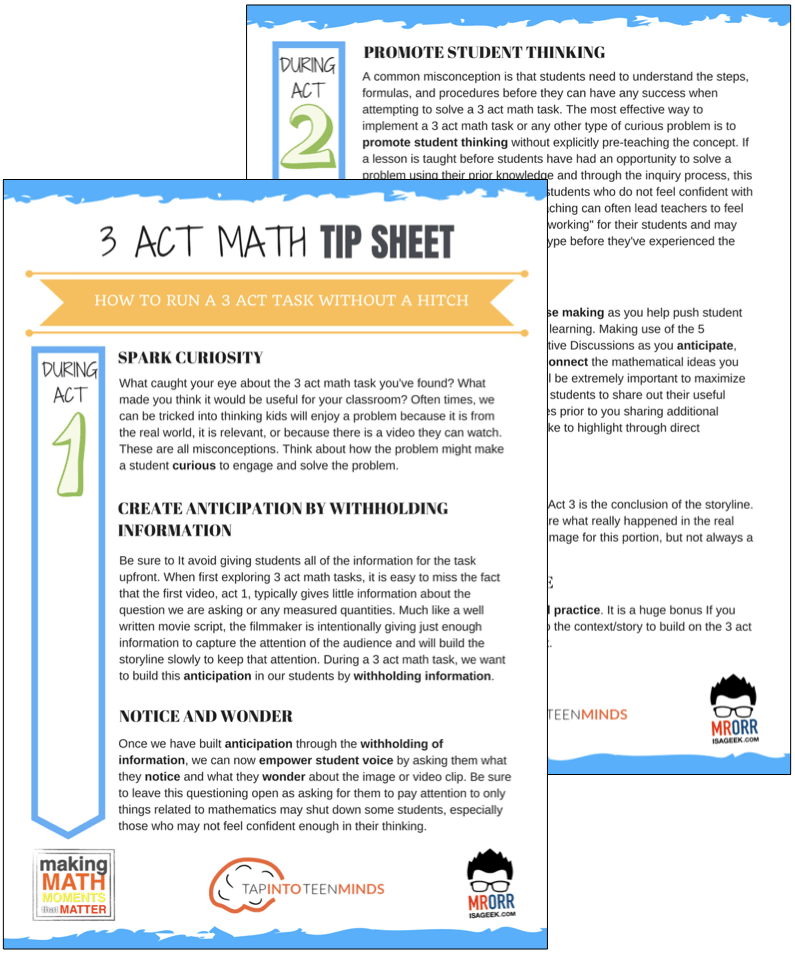
LESSONS TO MAKE MATH MOMENTS
Each lesson consists of:
Each Make Math Moments Problem Based Lesson consists of a Teacher Guide to lead you step-by-step through the planning process to ensure your lesson runs without a hitch!
Each Teacher Guide consists of:
- Intentionality of the lesson;
- A step-by-step walk through of each phase of the lesson;
- Visuals, animations, and videos unpacking big ideas, strategies, and models we intend to emerge during the lesson;
- Sample student approaches to assist in anticipating what your students might do;
- Resources and downloads including Keynote, Powerpoint, Media Files, and Teacher Guide printable PDF; and,
- Much more!
Each Make Math Moments Problem Based Lesson begins with a story, visual, video, or other method to Spark Curiosity through context.
Students will often Notice and Wonder before making an estimate to draw them in and invest in the problem.
After student voice has been heard and acknowledged, we will set students off on a Productive Struggle via a prompt related to the Spark context.
These prompts are given each lesson with the following conditions:
- No calculators are to be used; and,
- Students are to focus on how they can convince their math community that their solution is valid.
Students are left to engage in a productive struggle as the facilitator circulates to observe and engage in conversation as a means of assessing formatively.
The facilitator is instructed through the Teacher Guide on what specific strategies and models could be used to make connections and consolidate the learning from the lesson.
Often times, animations and walk through videos are provided in the Teacher Guide to assist with planning and delivering the consolidation.
A review image, video, or animation is provided as a conclusion to the task from the lesson.
While this might feel like a natural ending to the context students have been exploring, it is just the beginning as we look to leverage this context via extensions and additional lessons to dig deeper.
At the end of each lesson, consolidation prompts and/or extensions are crafted for students to purposefully practice and demonstrate their current understanding.
Facilitators are encouraged to collect these consolidation prompts as a means to engage in the assessment process and inform next moves for instruction.
In multi-day units of study, Math Talks are crafted to help build on the thinking from the previous day and build towards the next step in the developmental progression of the concept(s) we are exploring.
Each Math Talk is constructed as a string of related problems that build with intentionality to emerge specific big ideas, strategies, and mathematical models.
Make Math Moments Problem Based Lessons and Day 1 Teacher Guides are openly available for you to leverage and use with your students without becoming a Make Math Moments Academy Member.
Use our OPEN ACCESS multi-day problem based units!
Make Math Moments Problem Based Lessons and Day 1 Teacher Guides are openly available for you to leverage and use with your students without becoming a Make Math Moments Academy Member.
Partitive Division Resulting in a Fraction
Equivalence and Algebraic Substitution
Represent Categorical Data & Explore Mean
Downloadable resources including blackline masters, handouts, printable Tips Sheets, slide shows, and media files do require a Make Math Moments Academy Membership.
ONLINE WORKSHOP REGISTRATION
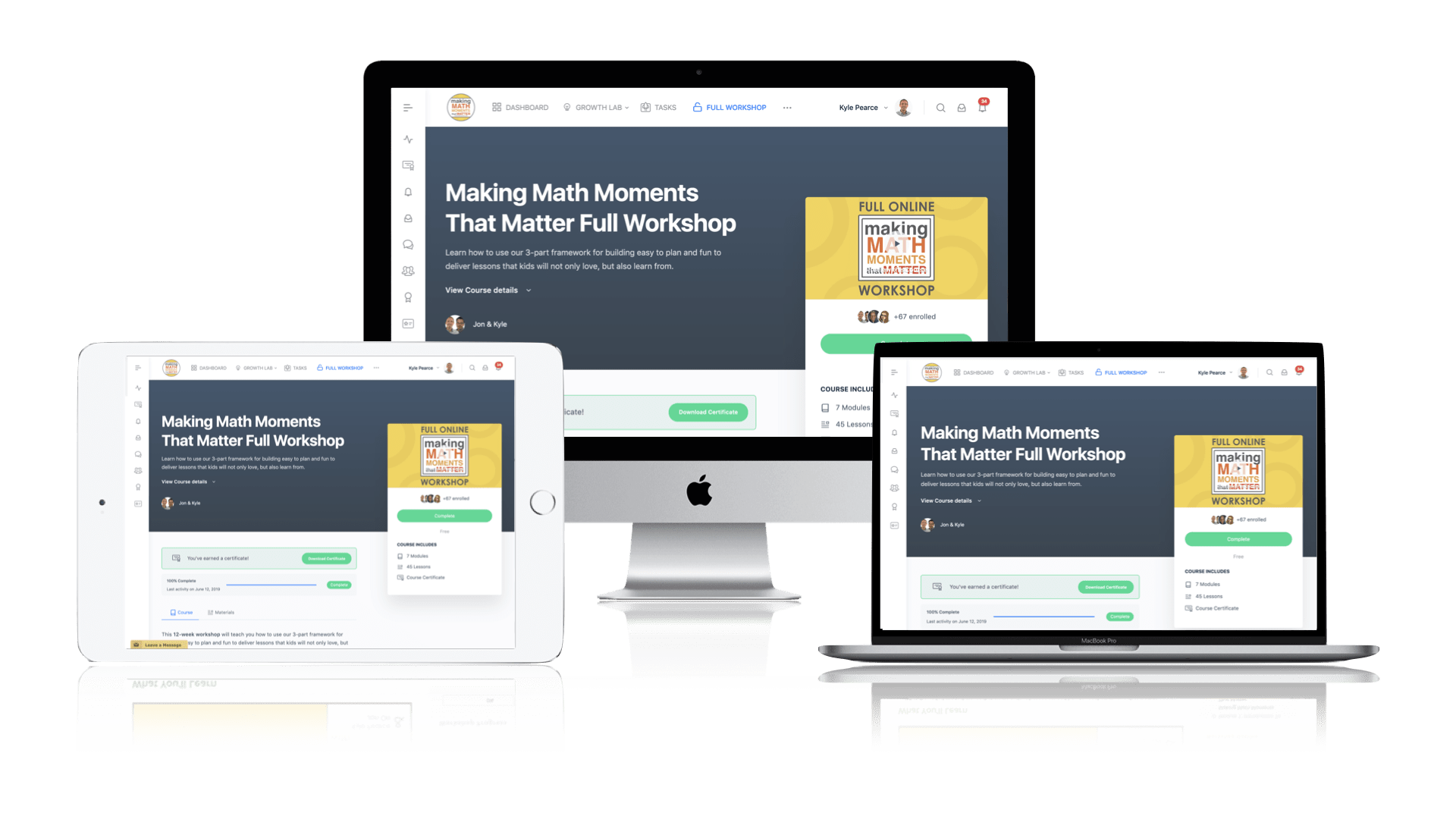
Pedagogically aligned for teachers of K through Grade 12 with content specific examples from Grades 3 through Grade 10.
In our self-paced, 12-week Online Workshop, you'll learn how to craft new and transform your current lessons to Spark Curiosity, Fuel Sense Making, and Ignite Your Teacher Moves to promote resilient problem solvers.
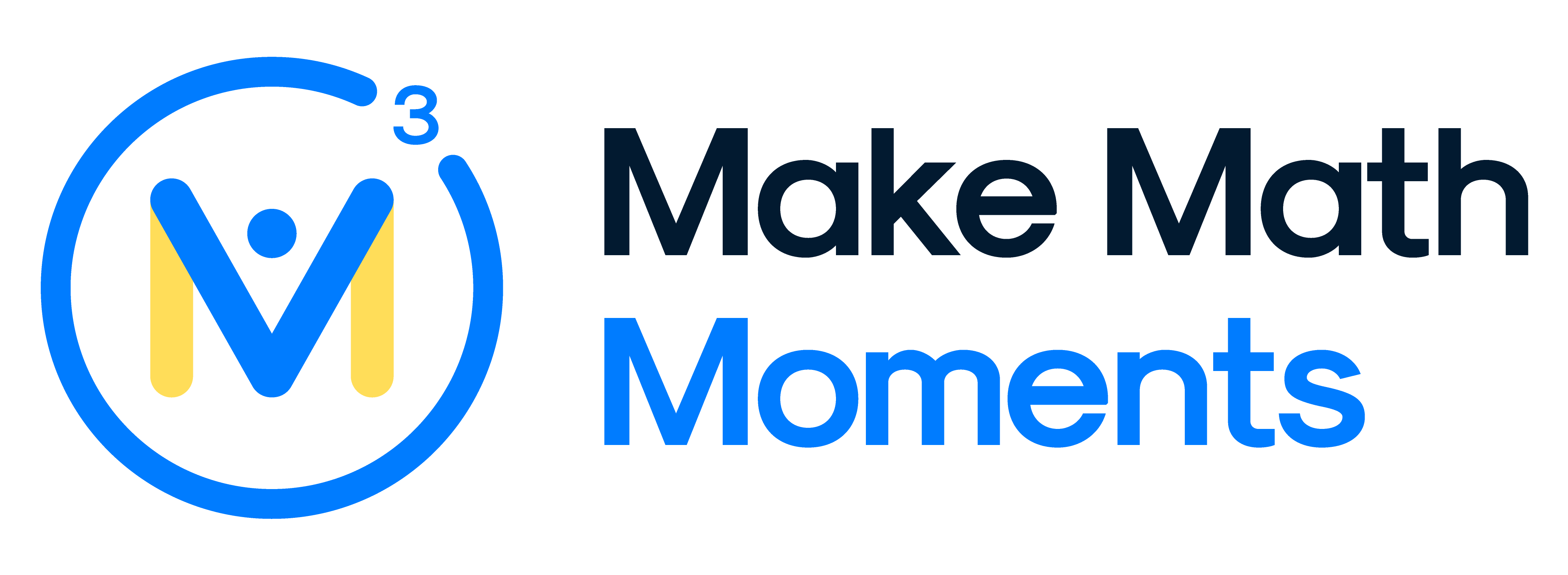



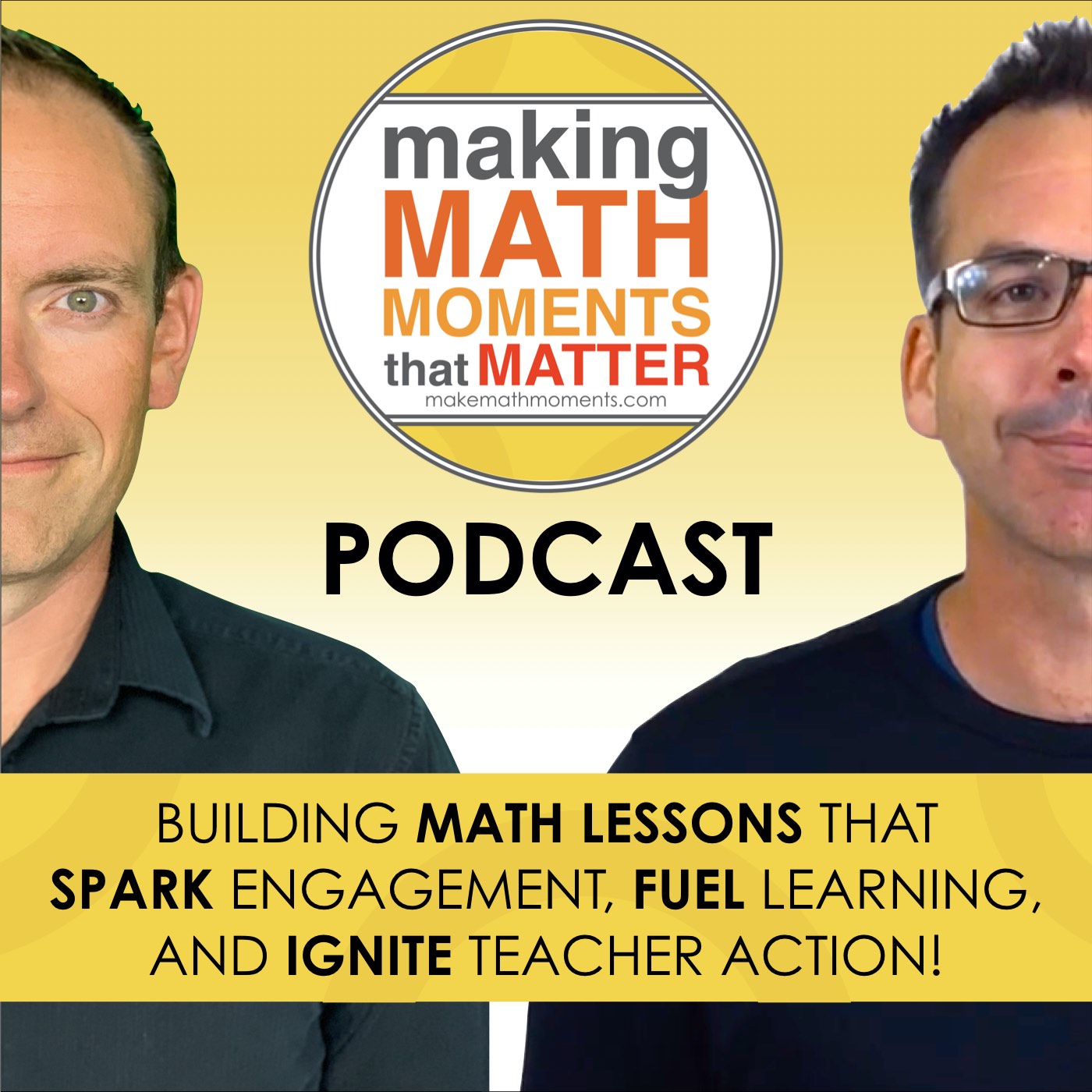
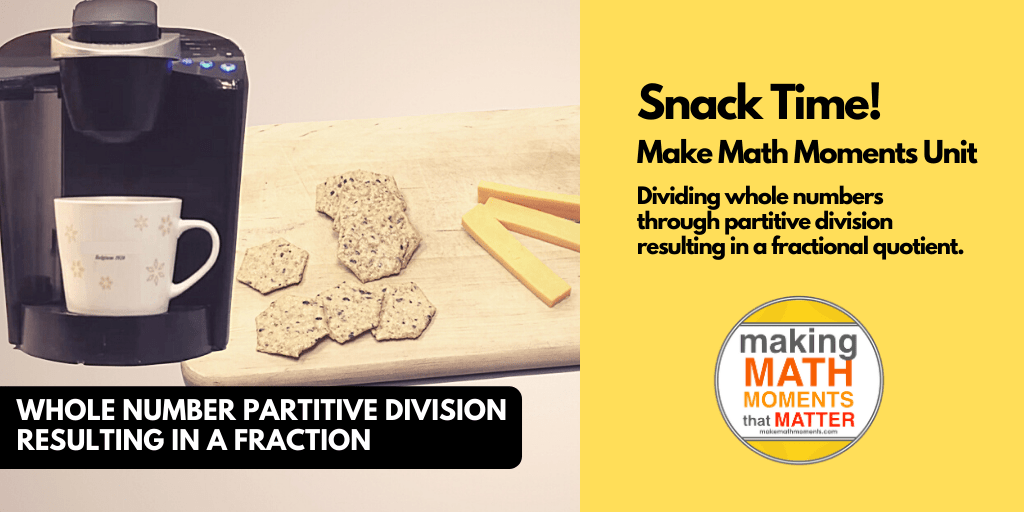

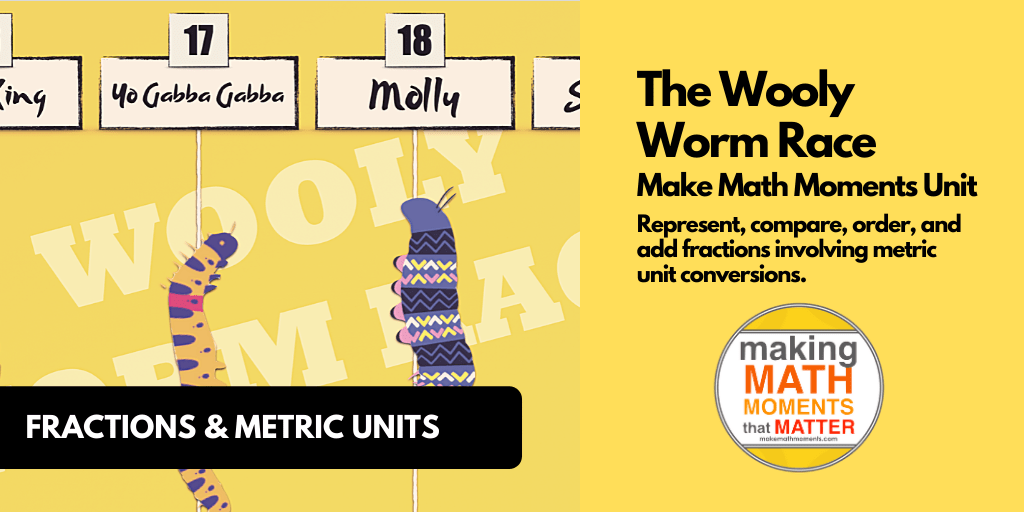
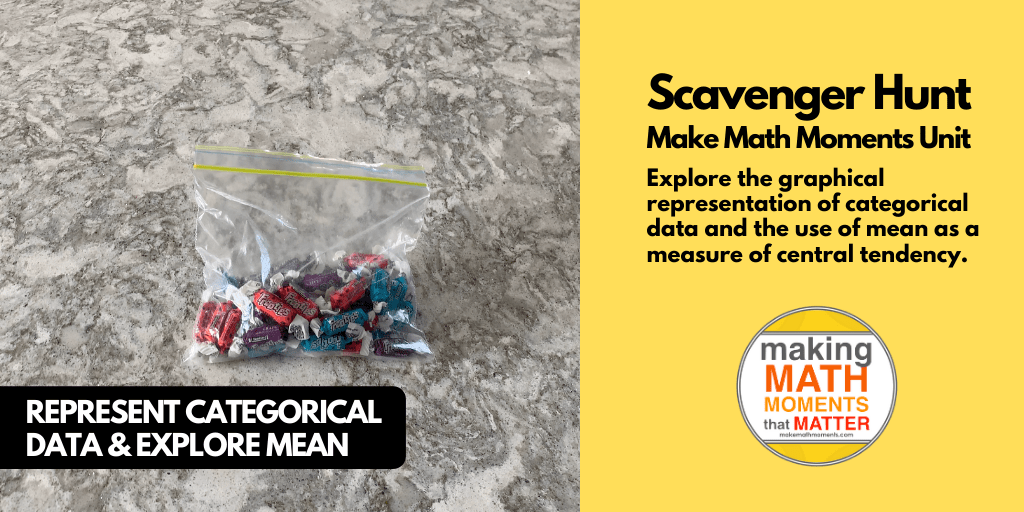

0 Comments